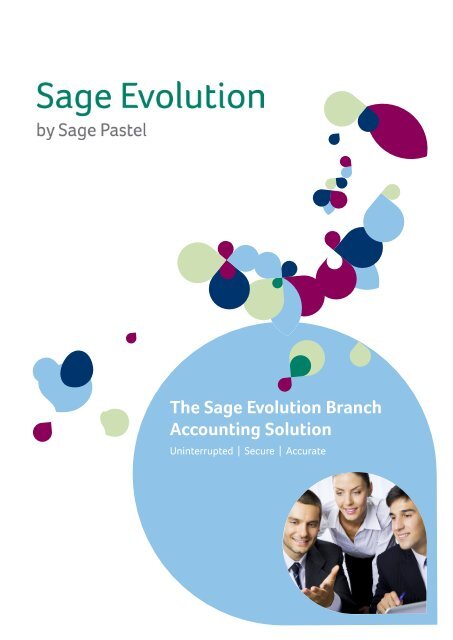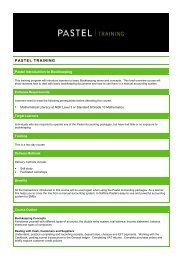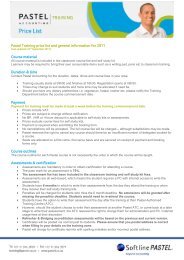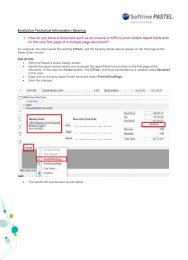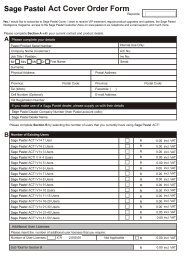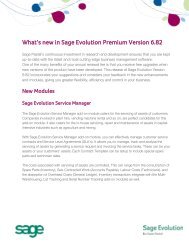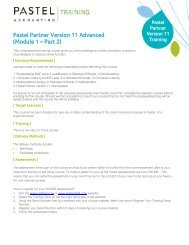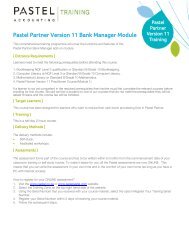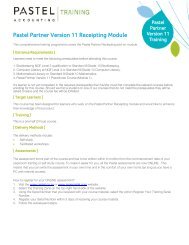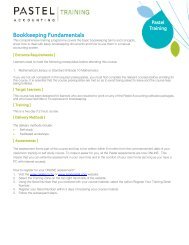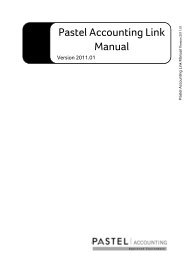White Paper - Sage Pastel
White Paper - Sage Pastel
White Paper - Sage Pastel
You also want an ePaper? Increase the reach of your titles
YUMPU automatically turns print PDFs into web optimized ePapers that Google loves.
Table of ContentsExecutive summary 03Objective of this document 03Who is meant to read this document 03The <strong>Sage</strong> Evolution Branch Accounting solution 04Scenarios 05Features & benefits 07Uninterrupted processing capacity 08Manage your data transfers 11Data transfer 13Preparing your business 14System requirements 15Branch Accounting | 2
ScenariosThe <strong>Sage</strong> Evolution Branch Accounting solution accommodates the following scenarios:Centralised (Online)In a centralised scenario, the head office and affiliated branches will log into the head office database via a terminal server or another means ofdirect access. This will update the head office database immediately.<strong>Sage</strong> Evolution DatabaseServer Details: SQL Server 2008 R2Branch ABranch CBranch BDecentralised (Offline)A decentralised scenario allows you to synchronise your branches’ data into the head office database for consolidated reporting using an FTPserver. Branches can transact locally and independently from the head office, using an FTP server to transfer data within the branch accountingenvironment. The frequency of the uploading and downloading of data can be specified according to organisational policies and procedures.Data uploaded from branches andconsolidted at head officeExport data tobranchesEvoltion DatabaseServer Details: SQL Server 2008 R2JohannesburgHead Office - PTATransactionsprocessed atbranchesWitbankCape TownPort ElizabethDurbanA branch transaction is logged as that specific branch’s transaction using the unique prefixes that the system automatically allocates using theconfiguration information. Branches will be restricted to global and branch specific information.Branch Accounting | 5
Business IntelligenceMulti-National ScenarioThe multi-national scenario allows you to operate a branch accountingenvironment across different countries.The following pre-requisites apply to this scenario:• The company has to decide in which currency they are going totrade and report in.• Branches can trade as normal entities using the Multi-Currencyadd-on module.• Business Intelligence Centre is required to convert the differentcurrencies to the selected trading and reporting currency.• Business Intelligence Centre is required for consolidated reporting.Head Office ($)FileTransferProtocolHead Office (ZAR)FileHead Office (£)TransferProtocolBranch A ($) Branch A (R) Branch A (£)Multi-Company ScenarioIf the head office is a trading company or yourbranches represent different types of entities, youwill create the head office as a “holding company”for consolidated reporting purposes.Data uploaded from branches andconsolidated at head officeHoldingCompanyExport data tobranchesEvolutionDatabase - ERPCloseCorporationTransactionsprocessed atbranchesCloseCorporationPrivateCompanyPrivateCompanyBusinessIntelligencePrivateCompanyThree Tier ScenarioRegionalHead OfficeHoldingIronTreeCompanyFTP FTP FTPRegionalHead OfficeRegionalHead OfficeThis scenario allows you to consolidate multiplebranch accounting environments into a holdingcompany for reporting purposes.The following pre-requisites apply to this scenario:• <strong>Sage</strong> <strong>Pastel</strong> IronTree must be used as a backupportal.• Multiple FTP folders are required.• Business Intelligence Centre is required toconvert the different currencies to the selectedtrading and reporting currency, if applicable.• Business Intelligence Centre is required forconsolidated reporting purposes.Branch A Branch B Branch A Branch B Branch ABranch BBranch Accounting | 6
The <strong>Sage</strong> Evolution Branch Accounting Solution offers you the followingkey features and benefitsLOGISTICS• Caters for Centralised or Decentralised Accounting for optimal productivity and accuracy.• Uses a powerful synchronisation tool which controls the transfer of data within the branch accounting environment witheffective time and alert management options.• The synchronisation process utilises a File Transfer Protocol (FTP) to transfer the data. This allows for full access andcontrol over data movements and history.• The transfer of data is secured by key identifiers. Each branch has a unique identifier attached to each master file, userand transaction created and processed at that branch, eliminating duplication.• Caters for a multi-entity environment.• Caters for a transacting head office environment.• Caters for a multi-national and three tier environment.MASTER FILES• Caters for Standard General Ledger and Segmented General Ledger structures.• Inventory items are automatically created as warehouse items.• Prefix your document numbering structures per branch.• Create branch specific transaction types to accommodate branch specific processing requirements.• Create branch specific master files for branch specific requirements.• Create global records which are consistent throughout the branch accounting environment.TRANSACTING• View branch specific transaction records on behalf of the branch at head office level at any time.• Utilise Inter-Branch Transfers to transfer stock and Loan Accounts to manage financials within your branch accountingenvironment.REPORTING• Produce consolidated reports at head office.• Produce branch specific reports at branch and head office level.• Customise reports using the Business Intelligence Centre (BIC) to accommodate your business structure for optimalreporting purposes.SECURITY• Minimises the risk of losing data due to natural or other disasters.• Ongoing ability to transact in the event of loss of connectivity in an offline environment.• Provides for a detailed Audit Trail with unique branch specific numbering to monitor user activity and transactional history.• The key identifiers attached to records determine which information is shared across the branch accounting environment,restricting branches to access global and branch specific records.Branch Accounting | 7
Uninterrupted Processing CapacityYou will independently transact at head office and branch level. Unique prefixes will differentiate the transactions at a consolidated level.Loan accountsInter-branch transfers and loan accounts are standard branch accounting features. Branches are sometimes subsidised by the holding company orhead office for expenses such as rent, salaries and/or stock which require loan accounts. Loan accounts are used to effectively account for thesesubsidised expenses from a financial perspective.The set up of loan accounts may vary from business to business and is entirely up to the business’s discretion. In order to report and display loanaccounts appropriately in the financials, it is recommended that a loan account per branch is set up, as well as a global head office loan accountfor consolidation purposes.1. Create branch specific loanaccounts and tick the loanaccount tick box.2. Create a global loan accountand tick the loan account tick box.3. Activate your cash book for interbranchtransactions and link it tothe global loan account.4. Activate your cash book forinter-branch transactions andlink it to the global loan account.Branch Accounting | 8
The Audit Trail at head office level displays the loan account distribution per branch.The loan accounts are created as liability accounts. The branch loan accounts are debited at head office level and the bank account is credited. Thisexpense is being financed by the head office in terms of an internal loan.Thereafter, at branch level the expense account, for example, rent, will be debited and the branch loan accounts will be credited, increasing theliability.Inter-branch transfersWhen a company requires the distribution of stock in a branch accounting environment, <strong>Sage</strong> Evolution allows the value of the stock issued to show as a loanto the branches. In most cases the head office will distribute the stock to all of the affected branches. However, the head office does not require the branchesto pay for the stock, but the stock leaving the head office must be accounted for from a financial perspective. This can be done through the use of stock loanaccounts at both head office and branch level.GoodsintransitHeadOfficeVarianceDamagesGoodsintransitGoodsintransitBranchABranchBVarianceDamagesVarianceDamagesBranch Accounting | 9
By activating the inter-branch transfers on the Warehouse Defaults at head office level and selecting the globalstock loan account, <strong>Sage</strong> Evolution will process the necessary transaction on your behalf.Goods in Transit (GIT)When you innitiate an inter-branch transfer, the systemplaces the items you are transferring into a GIT Warehouse.Variance GoodsWhen there is a variance between the stock Issued andthe stock Received, this difference will be allocated to theVariance Goods Warehouse.Damaged GoodsIf any stock was damaged during transit, it can be recordedand allocated to a Damaged Goods Warehouse.IBT Issue from head officeDebit: Stock goods in transit.Credit: Stock Account.IBTIBTIBT Receipt at branchDebit: Global stock loan accountand branch stock account.Credit: Stock goods in transit andbranch stock loan account.IBT Receipt at branchDebit: Global stock loan accountand branch stock account.Credit: Stock goods in transit andbranch stock loan account.IBT Issue at branchDebit: Branch stock loan accountand stock goods in transit.Credit: Branch stock account andglobal stock loan account.IBTbetweenbranchesIBT Receipt at branchDebit: Global stock loan accountand branch stock account.Credit: Stock goods in transit andbranch stock loan account.The net effect is that the stock control accounts are credited at head office and debited at branch level. This results in a zero balance in the goodsin transit warehouse and this will contra each other out at the consolidated level.Branch Accounting | 10
Manage your Data Transfers, uninterruptedThe Database Synchronisation Monitor makes provision for:• the transfer of financial data within a branch accounting environment;• the encryption of data;• scheduling of data synchronisation;• timeous error notifications using incidents and/or emails;• custom exports;• acknowledgement of successful sync file transfers;• automatic reconnection to FTP server at a polling interval;• a binary data transfer type;• universal times (UTC – Universal Time Control), meaning that if you synchronise in different countries, the sync monitor will adjust the time tothe applicable local time.ConfigurationThe configuration tool functions:Synchronisation FunctionsOptionDownloadImportExportUploadActivityDownloads the .dat file from the FTP site. If the head officerequests a manual process, do not select this option. Thehead office will manually download the .dat file from the FTPsite, and copy the file into the Update Path.Allows the downloaded .dat file to be imported into thehead office or the branch database.Allows the .dat files to be exported from the head office orbranch database.Allows the exported .dat file to be uploaded to the FTP site.Notification OptionsOptionIncidentEmailActivitySelect the agent responsible for monitoring thesynchronisation. An incident will be allocated to the selectedagent with regard to error notifications pertaining tothe synchronisation monitor.Enter the responsible agents email address in the applicablefield. Error notifications will be sent to the stipulated emailaddress.Branch Accounting | 11
The data synchronisation monitorThe data synchronisation monitor is a direct reflection of the progress of the data being transferred. A detailed activity log and update queue isvisible, disclosing the steps, file locations, data files and progress of data transfer.Click on the notepad icon to view thecomplete log file.Overview of the Branch Sync activity.This window displays a detailed log of the sync actions.You select the type of information displayed in thiswindow using the Configuration tool.• None• Full• Information• Warning• ErrorThis section displays the data files (.dat) being processedto and from the head office and branches and vice versa.The seeding means the following:0000 = Head Office0001 = Branch 10002 = Branch 29999 = Branch 99990001 0000 000001To>
Data TransferThe following diagram illustrates the upload, download, import and export processes in a decentralised environment.Head Office Sync MonitorBranch Sync MonitorHead OfficeExportUpdateFileDownloadFileBranchImportHead OfficeDatabaseFTP SiteTemporaryStorageBranchDatabaseHead OfficeImportDownloadFileUpdateFileBranchExportThe FTP server plays a vital role in the transfer of the data in a decentralised branch accounting environment and serves as the portal to which thedata is entrusted for a brief period of time. An FTP connection can be created in an active or passive mode. This determines how the data connectionis established.An FTP Spy tool will track and display detailed actions carried out by the FTP server.You can use any reliable FTP server but the Microsoft FTP server (running IIS 6.0 or later) is recommended.They Data Synchronisation Monitor encrypts the data ensuring that in the event of the FTP server being breached by an unknown source, the datawill not be able to be accessed, restored or distributed.Branch Accounting | 13
Preparing your business for a <strong>Sage</strong> Evolution BranchAccounting environmentAre you currently running a branchaccounting environment?NoAre you in the process of moving into abranch accounting environment?YesNoAre you currently running a:• Online or offline scenario?• Reporting head office scenario?• Transacting head office scenario?• Multi-entity scenario?• Multi-national scenario?• Other?YesAre you currently running <strong>Pastel</strong> Evolution?Yes NoConvert your data into a branchNew implementation:accounting environment?• Set up• Take on balances• MigrationYesDecide on the GL structure andaccounting period.Establish an IT infrastructureto manage the FTP and SyncMonitor.Create and configure headoffice and affiliated branches.Run the initial import from headoffice.Run reports at head office andbranches.Process and sync at head officeand branches.If...• you are running any branch accounting environment,• you are running a multi-national branch accounting environment,• you are running retail branches,then...• you need the Multi-Warehousing add-on module.• you will need the Multi-Warehousing, Multi-Currencyand BIC add-on modules.• you will need the Multi-Warehousing and Retail Pointof Sale add-on modules.Branch Accounting | 14
System RequirementsArea Single User Workstation Server (< 10 users) Server (11 - 20 users)HardwareMinimum Single Core 1 Ghz Single Core 1 Ghz Dual Core 2Ghz Dual Core 2GhzRecommended Dual Core or more Dual Core or more Quad Core or more Quad Core or more2Ghz or faster 2Ghz or faster 2Ghz or faster 2Ghz or fasterPLEASE NOTE: 32-bit (x86) and 64-bit (x64) processors are supported.Operating SystemMinimum Microsoft® Windows XP Microsoft® Windows XP Windows Server 2003 R2 Windows Server 2003 R2Professional Edition Professional Edition Standard Edition Standard EditionService Pack 3 or later Service Pack 3 or later Service Pack 2 or later Service Pack 2 or laterRecommended Microsoft® Windows 7 Microsoft® Windows 7 Windows Server 2008 R2 Windows Server 2008 R2Professional Edition Professional Edition Standard Edition Standard EditionService Pack 1 or later Service Pack 1 or later Service Pack 2 or later Service Pack 2 or laterPLEASE NOTE: Windows XP Home, Windows 7 Starter and Windows 7 Home Premium editions are not supported by <strong>Sage</strong> Evolution.RAMMinimum 2GB 2GB or more 4GB or more 4GB or moreRecommended 4GB or more 4GB or more 6GB or more 8GB or moreScreen ResolutionMinimum 1024 x 768 1024 x 768 1024 x 768 1024 x 768Database ServerRecommendedMicrosoft® SQL Server 2008 R2 - Service Pack 1 or laterSupported Microsoft® SQL Server 2012Additional Software Requirements ( Server and Workstation)Minimum Microsoft® Excel 2007 or later (for the Business Intelligence Centre module)Minimum .Net 4.00 framework (included in installation disc for the Bank Manager and Cash Manager modules)FTP (File Transfer Protocol) ServerRecommendedAdditional Important InformationMicrosoft® FTP running IIS 6.0 or later (for Branch Accounting environments)Recommended If you have 11 users or more on your network, we strongly recommend you speak to your <strong>Pastel</strong> Evolution Business Partnerregarding the system requirements recommended for your specific environment.Other System Requirements• DVD Rom.• 256 Colour VGA or SVGA Graphics.• The online help requires Internet Explorer version 6 or higher, or a compatible browser.• Up-to-date network drivers, service packs and updates for your network and operating systems.• Windows 7 personal computers/notebooks need to ensure that the recommended RAM memory requirements and Video Graphics adaptersare met.• The above serves as a guideline. Hardware requirements may differ depending on the operating system and the version of SQL Server.• For Microsoft® SQL Server 2012, please note that there are additional software requirements to adhere to. Please refer to the SQL Serverdocumentation for more information.Branch Accounting | 15


